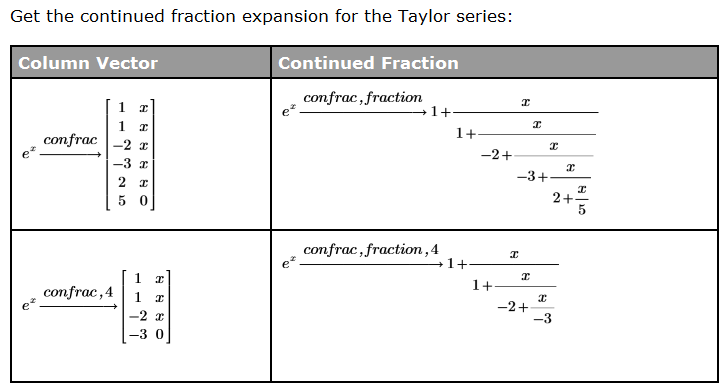Community Tip - Have a PTC product question you need answered fast? Chances are someone has asked it before. Learn about the community search. X
- Subscribe to RSS Feed
- Mark Topic as New
- Mark Topic as Read
- Float this Topic for Current User
- Bookmark
- Subscribe
- Mute
- Printer Friendly Page
Tangenta & sqrt by continued fractions
- Mark as New
- Bookmark
- Subscribe
- Mute
- Subscribe to RSS Feed
- Permalink
- Notify Moderator
Tangenta & sqrt by continued fractions
In the case of numbers, like tan(2), the Help provides clear information : figure after keyword confrac = number of accurate digits.
But what is the meaning of this figure in the case of the function tan(x) ?
Must confess that in the beginning it was a little bit confusing the display of the development of tan(x) by continued fractions...
(Pls. see attached)
Is there some trick to avoid the very tall vector of terms ? Probably by assigning the result of the symbolic evaluation by confrac to a variable without displaying the result...? Or would it be possible to have it in a usual table to scroll in ?
I think that for sqrt(x) and n-th root functions I have to look for in math books...
Best regards, Liv.
Solved! Go to Solution.
- Labels:
-
Other
Accepted Solutions
- Mark as New
- Bookmark
- Subscribe
- Mute
- Subscribe to RSS Feed
- Permalink
- Notify Moderator
OK, there may be a solution.
Here is a clumsy way to avoid the display of the long vertical vector other than hiding it in a collapsed region.

- Mark as New
- Bookmark
- Subscribe
- Mute
- Subscribe to RSS Feed
- Permalink
- Notify Moderator
Unfortunately the formatting option "table" does not apply to symbolic evaluations.
So the best I could think of is to hide the expression in a collapsed region and just show the result afterwards with numeric evaluation.
- Mark as New
- Bookmark
- Subscribe
- Mute
- Subscribe to RSS Feed
- Permalink
- Notify Moderator
I don't really understand your question.
From Prime 3.0 help:

- Mark as New
- Bookmark
- Subscribe
- Mute
- Subscribe to RSS Feed
- Permalink
- Notify Moderator
It seems that in Prime 3 symbolic confrac works better... (don't have Prime).
The display of the symbolic result in Mcd15 was confusing : don't understand the meaning of the number after the keyword in the case of a function, tan(x) in my example, since does not equal the number of terms. But probably it does in Prime 3 for functions...
Regards, Liv.
- Mark as New
- Bookmark
- Subscribe
- Mute
- Subscribe to RSS Feed
- Permalink
- Notify Moderator
Symbolics work the very same in Prime and in real Mathcad (15 or below).
The exact meaning of the integer parameter in case of a function isn't explained in the Prime help either.

- Mark as New
- Bookmark
- Subscribe
- Mute
- Subscribe to RSS Feed
- Permalink
- Notify Moderator
OK, there may be a solution.
Here is a clumsy way to avoid the display of the long vertical vector other than hiding it in a collapsed region.

- Mark as New
- Bookmark
- Subscribe
- Mute
- Subscribe to RSS Feed
- Permalink
- Notify Moderator
Great. The trick is worth to remember.
Don't agree : I wouldn't say clumsy, but the opposite !![]()
Thanks a lot, Liv.





